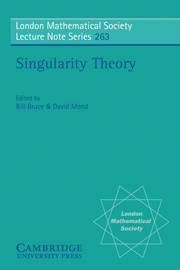 Singularity Theory
Singularity Theory Book contents
- Frontmatter
- Contents
- Preface
- Introduction
- Summaries of the Papers
- Complex Singularities
- Singularities Arising from Lattice Polytopes
- Critical Points of Affine Multiforms on the Complements of Arrangements
- Strange Duality, Mirror Symmetry, and the Leech Lattice
- Geometry of Equisingular Families of Curves
- Arrangements, KZ Systems and Lie Algebra Homology
- The Signature of f(x, y) + zN
- Spectra of K–Unimodal Isolated Singularities of Complete Intersections
- Dynkin Graphs, Gabriélov Graphs and Triangle Singularities
- Stratifications and Equisingularity Theory
- Global Singularity Theory
- Singularities of Mappings
- Applications of Singularity Theory
- References
Geometry of Equisingular Families of Curves
Published online by Cambridge University Press: 05 May 2013
- Frontmatter
- Contents
- Preface
- Introduction
- Summaries of the Papers
- Complex Singularities
- Singularities Arising from Lattice Polytopes
- Critical Points of Affine Multiforms on the Complements of Arrangements
- Strange Duality, Mirror Symmetry, and the Leech Lattice
- Geometry of Equisingular Families of Curves
- Arrangements, KZ Systems and Lie Algebra Homology
- The Signature of f(x, y) + zN
- Spectra of K–Unimodal Isolated Singularities of Complete Intersections
- Dynkin Graphs, Gabriélov Graphs and Triangle Singularities
- Stratifications and Equisingularity Theory
- Global Singularity Theory
- Singularities of Mappings
- Applications of Singularity Theory
- References
Summary
Dedicated to C. T. C. Wall on the occasion of his 60th birthday.
Introduction
Singular algebraic curves, their existence, deformation, families (from the local and global point of view) have attracted the continuous attention of algebraic geometers since the last century. The aim of our paper is to give an account of results, new trends and bibliography related to the geometry of equisingular families of algebraic curves on smooth algebraic surfaces over an algebraically closed field of characteristic zero. This theory is founded in basic works of Plücker, Severi, Segre, Zariski, and has close links with, and finds important applications in singularity theory, topology of complex algebraic curves and surfaces, and in real algebraic geometry.
We shall concentrate on the following traditional questions. Given some classification of isolated curve singularities we call an equivalence class a type. Then the discriminant in the linear system ∣D∣ on a smooth algebraic surface Σ is decomposed into the set of non-reduced or reducible curves and the sets V(D; S1,…, Sr) of (irreducible) curves in ∣D∣ having r singular points of types S1,…, Sr as their only singular points (in the sequel these sets are referred to as equisingular families – ESF). We ask:
• Is V(D; S1,…, Sr) non-empty?
• Is V(D; S1,…, Sr) smooth and does it have the “regular”, or “expected”, codimension in ∣D∣ (expressed in terms of S1,…, Sr)?
[…]
- Type
- Chapter
- Information
- Singularity TheoryProceedings of the European Singularities Conference, August 1996, Liverpool and Dedicated to C.T.C. Wall on the Occasion of his 60th Birthday, pp. 79 - 108Publisher: Cambridge University PressPrint publication year: 1999
- 4
- Cited by
